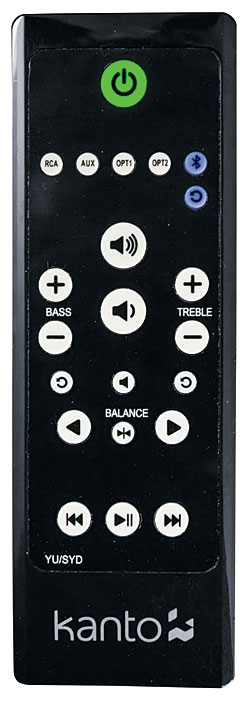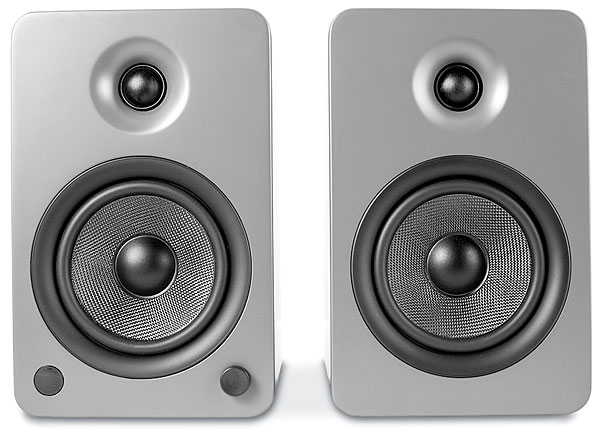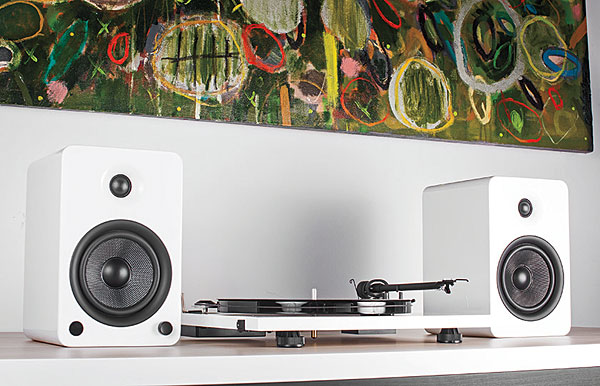Kanto YU6 Powered Speaker System Review Page 2
 The Köln Concert is the jewel of Keith Jarrett’s solo works as well as one of my go-to picks for a beautifully engineered piano recording. It taught me not to typecast Kanto’s gentlevoiced silk dome as a softie: The full beauty of the instrument’s complex and glittering harmonics came through. I was happy to hear just enough of Jarrett’s left hand without a sub. Another favorite piano recording is Paul Jacobs’ Nonesuch collection of Debussy’s Preludes. The speakers constructed a generously proportioned soundstage for the magisterially dark Bösendorfer Imperial, turning Jacobs’ fleet-fingered runs into fluid shapes that undulated colorfully like exotic tropical sea creatures. It was hypnotic; I forgot all about notes and keys and vinyl and drivers.
The Köln Concert is the jewel of Keith Jarrett’s solo works as well as one of my go-to picks for a beautifully engineered piano recording. It taught me not to typecast Kanto’s gentlevoiced silk dome as a softie: The full beauty of the instrument’s complex and glittering harmonics came through. I was happy to hear just enough of Jarrett’s left hand without a sub. Another favorite piano recording is Paul Jacobs’ Nonesuch collection of Debussy’s Preludes. The speakers constructed a generously proportioned soundstage for the magisterially dark Bösendorfer Imperial, turning Jacobs’ fleet-fingered runs into fluid shapes that undulated colorfully like exotic tropical sea creatures. It was hypnotic; I forgot all about notes and keys and vinyl and drivers.
I so enjoyed listening to this system with vinyl that I basically lost control. LPs fell off the shelves and spun themselves as if they had a will of their own. One that unexpectedly stood out featured Robert and Gaby Casadesus playing Bach in the Odyssey budget-label release of Two Concertos for Two Pianos. What had previously seemed bland and muddy took on more spatial shape and coherence; the Kantos had a knack for extracting the musical essence from an indifferent, distant-miked recording that has eluded many other systems. In Handel’s Water Music, with Yehudi Menuhin leading the Bath Festival Orchestra, solo passages for oboe, flute, and other instruments were vividly and colorfully imaged, while the full tout ensemble had a rude vitality. Records that were inherently vivid and colorful got even better. Playing Bernard Herrmann’s soundtrack from Alfred Hitchcock’s Vertigo, I couldn’t have asked for a sweeter string sound than I got from the Kantos’ silk-dome tweeters and this Mercury vinyl.
Then the Digital
Going from the Micro Junior turntable to a pair of Bluetooth-connected tablets—a 2016 Samsung Galaxy Tab A 10.1 and a 2013 iPad mini with Retina display— was a step down in fidelity. Not necessarily because digital is inherently inferior to analog. (If I were to wade into that discussion at all, it would also be foolhardy to disregard recording and mastering quality vagaries between different sources.) But Bluetooth transmission requires lots of compression, and if the original material is already compressed, then it gets compressed again, and the artifacts of both compression methods interact. The mathematical result of these “cascading codecs” is called concatenation error, and reduced fidelity is the result. Even the higher-quality aptX favored by Kanto has its limitations, but it’s an improvement over the default codec. When the tablets played Apple Lossless, the result was always compressed by the time it reached the speakers. MP3 files, already in a lossy file format, took the worst hit.
The diminishment was mostly in the top end. It was less refined, less colorful, and less palatable at high volumes. But the system retained its bass solidity and overall balance. With Donald Fagen’s Sunken Condos (ripped from CD to MP3 at 192 kilobits per second), the musical grooves were unimpaired, and the clean, flat recording style didn’t call attention to the soso treble of the lossy compression. In the Grateful Dead’s informally named Skull & Roses live album (ripped from LP to MP3 at 192 kbps), the Kantos cavorted merrily with Phil Lesh’s meandering bass, distracting me from the slight blurring of voices and guitars, especially Jerry Garcia’s treble-rich tone. The irony of combining (minor) surface noise with lossy compression was not lost on me.

If I hadn’t been familiar with the CD from which I had ripped Robyn Hitchcock’s self-titled album in Apple Lossless, I might have been pretty impressed with Bluetooth’s delivery of its jangly electric textures. Bluetooth is more of a minor irritant (or a subtle letdown) than a bed of nails. But when I got to hi-res orchestral material—Beethoven’s Symphony No. 9 as played by Claudio Abbado and the Berlin Philharmonic (FLAC 96/24)—there was no way to ignore the coarsening of the string section during the loudest passages. And there is no way to play the Ninth except loud. Background music it is not.
So I loved the YU6 with vinyl and got mixed results with digital via Bluetooth. But what would happen if I plugged an uncompressed or lossless digital source or two into the optical or analog inputs? The logical first step was to play the CDs from which some of the abovementioned titles were ripped. I connected my trusty old Oppo BDP-83SE universal disc player to one of the YU6’s optical inputs. Then, cueing up the CDs on the Oppo and their ripped files on the Samsung tablet, I ran them simultaneously.
The levels sounded identical, which made valid A/B comparisons possible, but I had to admit that the difference between the Fagen CD and its MP3 version was so minimal as to be meaningless. I noticed a slightly more discernible difference when I compared the Hitchcock CD with its ALAC files. The album’s brighter textures made it possible to hear that the CD was just slightly smoother, and it left me more relaxed. Still, as I had thought before, the Bluetooth was far from unlistenable.

To make things interesting, a few songs into the Hitchcock, I connected the Oppo’s Special Edition analog outputs to the Kanto’s RCA inputs and toggled the RCAs from phono to line duties. The Oppo’s analog outs consistently sounded better than the other two to a degree that would be meaningful with long-term listening. This might have indicated that the Oppo SE player has a better DAC than the Kanto. That would be no surprise, as the Oppo originally cost twice as much, and the analog-out DAC was that Special Edition’s key feature.
Still, it took a whole lot of content, signal sources, and connection methods to find anything that would frazzle the system, and its good moments outnumbered its bad ones by several bushels. As Monty Python once said, “He was a cruel man, but fair.”
The Kanto YU6 is a fabulous two-channel starter system as well as a great way to work vinyl into your listening life even if you want to keep things on the simple and inexpensive side. It also excels with digital sources, though if you’re not using a turntable, it would be unwise to rely entirely on Bluetooth; you’ll get the best results with a USB DAC playing lossless material or (dare I say it) with a CD player. Feed these little guys the good stuff, and your interest in music will grow and grow.




























































